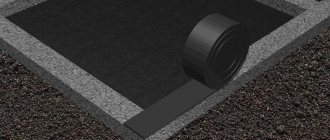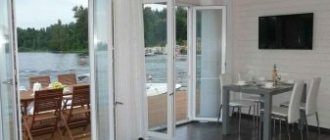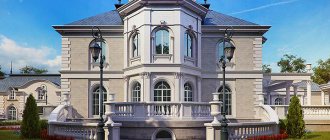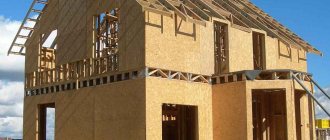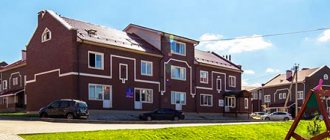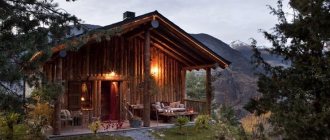Many people dream of a private home, because they so want to escape from the bustle of the city. But a private house is an expensive pleasure, which is due to the rising cost of building materials. Brick, natural wood, and stone are becoming increasingly unavailable for individual construction, so representatives of the construction industry and their clients were forced to search for more economical materials with similar characteristics. And they were found! High-quality, relatively light gas silicate
Today they are widely used for commercial and private construction.
Houses built from aerated concrete have an attractive appearance
, they
are resistant to temperature changes
, so they can be erected in regions with any type of climate. It is cool in such houses in summer and very warm in winter, so owners of aerated block houses will feel comfortable!
Houses have a number of characteristics, in some cases their quality exceeds the quality of buildings built from brick or wood. The porous structure of the material is the key to excellent thermal insulation
, resulting in good savings on heating costs. Gas silicate used in individual construction can be combined with other materials, which improves its performance characteristics.
Home selection
Objects we have built
House made of ceramic blocks in Lobnya.
At the end of summer, our company commissioned a house made of ceramic blocks with a basement floor and a roof made of soft tiles in Lobnya. Basic indicators:
- Start of house construction: July 2021
- Completion of construction: August 2021
- House made of ceramic blocks with a basement with a soft roof
- Ground floor area 125m2
- 154m3 of concrete was used to fill the base
- A 440 mm porous block was used for the walls; the total volume of the block was 145.2 m3
- The roof is made of Tegola Alpin soft tiles, a drainage system and snow retention are installed
- Total roof area 460m2
- The house is lined with domestic facing bricks; to save material, the bricks were cut in half.
- Facing area is about 400m2
House made of ceramic block in Zdravnitsa
A house made of ceramic blocks on a slab foundation with a roof made of soft tiles and trimmed with cut facing bricks in the village of Zdravnitsa, Moscow region, according to a project completed by our company (section AC).
Basic indicators:
- The total area of the house is 261 m2, on the ground floor there is a large living room with a second light and an arched window along the entire height of the facade, a kitchen, a dressing room, a boiler room and a spacious glazed veranda in the bay window. On the second floor there are three bedrooms, two dressing rooms, a children's room, a balcony-patio, and a large garage for two cars was designed in the house.
- The house was built on a flat plot, the soil was clay, and a slab foundation was designed and built.
- A 380 mm porous block was used for the walls, the total volume of the block was 133 m3, the partitions were made of working bricks.
- The roof is made of soft tiles Rancho TECHNONICOL SHINGLAS, a drainage system is installed, snow retention
- Total roof area 314.5 m2
- The house is lined with Austrian facing bricks; to save material, the bricks were cut in half; painted larch planks and decorative stone were also used to decorate the facade.
- The area of facing with brick is about 183 m2, with wood 72 m2, facing stone - 220 m2
- The inside of the house is plastered with gypsum plaster, screeds and heated floors are installed.
- At the moment, the interior decoration, communications and landscaping of the site are being completed.
House made of ceramic block in Zvenigorod
A house made of ceramic blocks with a ground floor and a roof made of soft tiles and finished with light plaster in the Zvenigorod area of the Moscow region according to the customer’s project.
Basic indicators:
- The total area of the house is 346 m2, the house is built on a flat, dry plot, the soil is clay, the foundation is a monolithic ground floor with waterproofing and a drainage system.
- For the walls, a porous Wienerberger block 510 mm was used. The partitions are made of working bricks on mortar, the floors are prefabricated reinforced concrete slabs.
- The roof is made of Shinglas soft tiles.
- The property has been commissioned, exterior and interior finishing, communications, and landscaping have been completed.
House made of ceramic blocks 140m2
A house made of Wienerberger51 ceramic blocks on a columnar strip foundation with a roof made of polymer sand tiles and finished with light plaster in the village of Papineau.
Construction of a house from a Wienerberger51 ceramic block on a columnar strip foundation with a roof made of composite tiles and finished with light plaster in the village of Papino, Kaluga region. The project (section AC) of the house was developed by the designers of our company.
Basic indicators:
- The total area of the house is 140 m2, 1st floor and attic, balcony, covered terrace.
- The house was built on a relatively flat area, the soil was clay; in order to save money, a columnar strip foundation with a monolithic slab was designed and built.
- The masonry of the walls is made of Wienerberger51 ceramic blocks on a warm masonry mixture.
- The roof is made of polymer sand tiles.
At the moment, the object is completely finished and put into operation, people live in the house permanently.
House made of aerated concrete block
Based on the customer’s sketches, our architect completed the project and built a house from an aerated concrete block within a season.
Key indicators in the project:
- The total area of the house is 260 m2, 2 full floors and a usable attic.
- House made of aerated concrete block on a columnar strip foundation with a soft roof
- Wall masonry volume 138m3
- For the walls, an aerated concrete block with a density of M-400 was used, the thickness of the external walls was 400 mm
- The roof is made of soft Katepal tiles, a drainage system is installed.
- Total roof area 344m2
House Tuchkovo
A one-story house made of a 400 mm thermal block on a pile-strip foundation with a metal tile roof in Tuchkovo.
The project (section AC) was developed by the designers of our company.
Basic indicators:
- The total area of the house is 114 m2, 1st floor.
- The house was built on a flat plot, the soil is clayey, watered, a pile-strip foundation was designed and built.
- The masonry of the walls is made of Cheboksary thermal block 400mm thick, painted with facade paint. The partitions are made of working bricks on mortar, the ceilings are laid on wooden beams.
- The roof is made of Optima Grand Line metal tiles.
- The object has been handed over, the exterior finishing has been done
House Sportville
A house with a garage made of a 400 mm aerated concrete block on a pile-strip foundation with a slab under the roof made of composite tiles in the Sportville community center.
The architectural design of the house was provided by the Customer, the working design (section KR) was developed by the designers of our company.
Basic indicators:
- Construction of Sportville with a total area of the house 260 m2, 1st floor and attic, balcony, garage.
- The house was built on a site with a height difference of up to 800 mm, the soil is clayey, a pile-strip foundation with a slab on the ground was designed and built.
- The masonry of the walls is made of Aerostone 400mm aerated concrete block with glue, the walls are insulated with 100mm polystyrene foam, on which light plaster and clinker tiles are applied, decorative elements “like half-timbering” made of larch are added. The lintels are monolithic, a reinforced concrete interfloor ceiling and a monolithic anti-seismic belt are poured.
- The roof is made of Luxard composite tiles.
- Construction has been completed, the object has been handed over, the exterior and interior decoration, porch, landscaping have been done, including the foundation for the bathhouse.
House Vysokovsk
A two-story house made of a 400 mm aerated concrete block with brick cladding with a monolithic basement and a metal tile roof in Vysokovsk.
The project was provided by the Customer, our designers finalized individual components.
Basic indicators:
- The total area of the house is 213 m2, basement + 2 floors.
- The house was built on a site with a slight difference in elevation, the soil is clay, the ground floor has a height of 2500 mm.
- The masonry of the walls is made of Bonolit 400mm aerated concrete block with glue; the outside of the house is lined with brick. Interfloor ceilings are reinforced concrete.
- Roofing: Tegola soft tiles.
- The property has been commissioned, exterior and interior finishing, communications, and landscaping have been completed, including retaining walls and fences.
House of Chekhov
A one-story house made of a 400 mm thermal block on a pile-strip foundation with a slab and a metal roof in the Chekhov district.
The project (section AC) was developed by the designers of our company.
Basic indicators:
- The total area of the house is 157 m2, 1st floor.
- The house was built on a site with a height difference of up to 80 cm on the bank of a river, the soil is clayey, water-logged, a pile-strip foundation with a slab was designed and built.
- The masonry of the walls is made of Cheboksary thermal block 400mm thick, painted with facade paint. The partitions are made of working bricks and mortar, the floor is a monolithic slab, the ceiling is made of wooden beams.
- The roof is made of Optima Grand Line metal tiles.
- The object has been handed over, the exterior finishing has been done
More
details
More details
More details
More details
More details
More details
More details
More details
View other houses
How to build housing from gas silicate
Today, when you can easily find instructions on the Internet for assembling structures for various purposes, many novice craftsmen try to build with their own hands. This is a good trend, given the possible savings on work. But the negative side is that through one stage of saving, another is almost imperceptibly selected when the technology is processed by replacing materials with cheaper ones. As a result, a poor foundation that cannot properly distribute loads, a large number of cracks in the walls, open seams, sloping levels of masonry walls of the house, and, accordingly, unsatisfactory quality of the project as a whole. Therefore, if you have a desire to build yourself, we recommend starting with inexpensive and small commercial buildings, rather than critical residential buildings. But it is more correct, in order to obtain a high-quality construction result, as well as accompanying guarantees, to contact craftsmen with the appropriate education and practical experience! We offer you not only designs for houses made of silicate blocks, but also a full range of construction work, upon completion of which you will be given the keys to your new home. Build a new cottage or dacha with our company in just one season, and we guarantee that you will contact us again and again!
Stages of work
1
Design
Our company carries out the full scope of work on designing houses from aerated concrete-gas silicate block, including sections KR and AR. We can design a house from scratch according to the Customer’s sketch and technical specifications or adapt a finished project taking into account all the wishes of future residents, current SNiP and GOST.
Order a free estimate Get expert advice 8 495 763-51-01
2
Construction of the foundation
For houses made of aerated concrete-gas silicate block, deep strip foundations are most suitable, when the strip, with or without expansion, rests on non-freezing layers of soil, usually at an elevation of more than -1700 mm. Building a basement floor may also be an excellent choice, since this type of foundation will add additional usable space to the house, where you can place technical rooms, a gym or a sauna. The most economical of the possible foundation options for a house made of aerated concrete is a columnar-strip foundation, when a strip with a small cross-section distributes the load onto pillars with a supporting heel. A good option for such a house would be a pile-grillage (pile-strip) foundation. It is possible to use different types of slab foundations .
Order a free estimate Get expert advice 8 495 763-51-01
3
Wall masonry
The laying of the GAS SILICATE block is done using special glue. To level the concrete of the foundation, a cement-sand screed is made, and hydroglass insulation is laid under all walls. The masonry is reinforced with galvanized metal mesh. To cover openings, special aerated concrete or reinforced concrete lintels are used; non-standard openings are covered with monolithic lintels manufactured locally.
Order a free estimate Get expert advice 8 495 763-51-01
4
floors
For interfloor floors, it is possible to use ready-made reinforced concrete floor slabs; in such cases, concreting of monolithic belts is required to support the slabs. A monolithic floor is considered more reliable, but more expensive, when a “table” is set up from plywood using racks, tripods and crossbars - slab formwork, a reinforced frame is tied and the floor slab is concreted on site. The cheapest option is to cover it with wooden joists. As is easy to understand, such a ceiling, at a low cost, can creak and sag during operation, and the wood is susceptible to rot and fungus.
Order a free estimate Get expert advice 8 495 763-51-01
5
roof
Any type of roof is suitable for covering houses made of aerated concrete-gas silicate blocks. We use in our work the most expensive, environmentally friendly and natural ceramic tiles, cement-sand tiles, very often our Customers choose soft tiles from domestic and foreign manufacturers. Metal tiles are the most affordable; the choice of manufacturers is also very large. The rafter system is assembled from wood pre-treated with fire retardant; the roof can be either insulated or cold.
Order a free estimate Get expert advice 8 495 763-51-01
6
finishing
A cottage made from a GAS SILICATE block can be finished with facing bricks, clinker, all types of plaster can be used, ventilated and combined types of facades are used. During interior finishing, walls are plastered and floors are screeded, after which any type of finishing can be used.
Order a free estimate Get expert advice 8 495 763-51-01
Quantity calculation
In order to build any object, you must first calculate the number of products required for this. Knowing the size of the blocks and the area of the walls being built, this is quite easy to do. But first it is necessary to convert the block sizes indicated in millimeters into meter measurements and determine its cubic capacity, and then the number of blocks in one cubic meter of material is calculated.
It should be borne in mind that gas silicate blocks are sold in packages placed on wooden pallets, and all measurements are made exclusively in cubic meters, although in some cases in construction markets you can purchase the material individually, but in this case we are talking about small volumes - no more than 50 units.
Example of calculating a block 600×200×300
- First, we convert the dimensions into meters and get 0.6 × 0.2 × 0.3.
- We determine the volume of one block by simple mathematical multiplication of the sides - 0.36 m³.
- In order to find out the number of blocks in 1 m³, divide 1 (unit) by 0.36.
- We get 27.8 blocks per 1 m³.
- After this, similarly, you should determine the number of blocks corresponding to the size of 1 m³ of wall masonry.
- In this example, two values are obtained - 5.6 and 8.3 units, depending on whether the width of the masonry is 20 or 30 cm.
Having calculated the required number of cubic meters of gas silicate for construction, the resulting value can be multiplied by the price of 1 m³ and get the total amount that needs to be spent. Depending on the manufacturer, region of the country, the price of 1 m³, on average, is from 3,000 to 4,000 rubles. The price per piece of a gas silicate block 600×200×300 is 110-140 rubles.
In addition to the price set by the manufacturer, other factors also influence the pricing of gas silicate.
- the cost of delivery and the further the blocks are transported, the more expensive they become;
- self-pickup of goods significantly reduces the cost compared to transporting them by the seller, and even more so by renting commercial vehicles;
- the presence or absence of a dealer chain - buying directly from the manufacturer is always cheaper;
- Manufacturers and their dealers are always willing to offer discounts or bonuses to large wholesale and regular customers.
Reviews
Marianna and Sergey Zh. 30 years old
We were asked to write a review for Ritmstroy LLC and how they built our house for us, so we’ll tell you in order: we first found these guys on the Internet when we were looking for a contractor to complete our project.
We already had our own project, we did it with friends. At the request “construction from ceramic blocks” a bunch of companies came up at once, we took and sent requests to all of them at once from the first page. The person from “Ritmstroy” contacted us the fastest, the rest were not so prompt, some Read more
Sergey Petrovich K. 57 years old.
We decided to build a house a long time ago, the children are adults, we want to live for ourselves, we looked and bought land, but finding a suitable project turned out to be difficult.
My wife and I have visited many sites with ready-made solutions - but nothing is right! Either the garage is larger than the house, or the staircase sticks out in the middle of the living room incomprehensibly... Friends recommended the Ritmstroy company to me, they built the basement floor with them, then they really had to do construction
Read completely
Marianna and Sergey Zh. 30 years old
We were asked to write a review for Ritmstroy LLC and how they built our house for us, so we’ll tell you in order: we first found these guys on the Internet when we were looking for a contractor to complete our project.
We already had our own project, we did it with friends. At the request “construction from ceramic blocks” a bunch of companies came up at once, we took and sent requests to all of them at once from the first page. The person from “Ritmstroy” contacted us the fastest, the rest were not so prompt, some Read more
Marianna and Sergey Zh. 30 years old
We were asked to write a review for Ritmstroy LLC and how they built our house for us, so we’ll tell you in order: we first found these guys on the Internet when we were looking for a contractor to complete our project.
We already had our own project, we did it with friends. At the request “construction from ceramic blocks” a bunch of companies came up at once, we took and sent requests to all of them at once from the first page. The person from “Ritmstroy” contacted us the fastest, the rest were not so prompt, some Read more
Sergey Petrovich K. 57 years old.
We decided to build a house a long time ago, the children are adults, we want to live for ourselves, we looked and bought land, but finding a suitable project turned out to be difficult.
My wife and I have visited many sites with ready-made solutions - but nothing is right! Either the garage is larger than the house, or the staircase sticks out in the middle of the living room incomprehensibly... Friends recommended the Ritmstroy company to me, they built the basement floor with them, then they really had to do construction
Read completely
Marianna and Sergey Zh. 30 years old
We were asked to write a review for Ritmstroy LLC and how they built our house for us, so we’ll tell you in order: we first found these guys on the Internet when we were looking for a contractor to complete our project.
We already had our own project, we did it with friends. At the request “construction from ceramic blocks” a bunch of companies came up at once, we took and sent requests to all of them at once from the first page. The person from “Ritmstroy” contacted us the fastest, the rest were not so prompt, some Read more
All reviews
Which gas silicate blocks to use for partitions
Gas silicate blocks for the construction of partitions should be chosen at least 100-175 mm, because they have good sound insulation and high strength.
D500-600 grade gas blocks are suitable for partitions.
On a note!
It is worth considering that if there is something hanging on the wall, for example, a TV or a small bookshelf, then you should take a closer look at the thickness of at least 150-200 mm, but with additional strengthening of each subsequent 4 rows of masonry.
Differences between aerated concrete and gas silicate
There is a difference between aerated concrete and a gas silicate building material with similar properties, despite the fact that both of them consist of cement, lime, ground or fine sand, water and gas-forming (to form pores) additives (aluminum powder or paste). The differences lie in the proportions of these main components and production technology.
Aerated concrete is a mixture based on Portland cement: its composition ranges from 50% to 70%. It consists of 20-40% sand, 1-5% lime, 0.25-0.8% water and 0.04-0.09% blowing agent. When the concrete mass hardens, aluminum and lime (with the participation of a gas-forming agent) enter into a chemical reaction, due to which spherical pores are formed in it, the diameter of the voids is 1-3 mm.
Gas silicate has a binder base of lime-silica: the mixture contains silicate sand in an amount of 60% and lime - 24%. Pores are formed by aluminum paste or powder. Due to the different content of the main components, the color is different - grayish and white, respectively.
What is aerated concrete
Aerated concrete is a building material from the cellular concrete family. It has a porous structure, thanks to which it acquires its working qualities and advantages:
- light weight;
- ability to store thermal energy;
- soundproofing of premises;
- high vapor permeability.
The presence of such qualities makes the material a very good option for the construction of private, country houses and other buildings of small height. The limit on the number of floors of buildings, determined by SNiP, is 3 floors. A country house made of aerated concrete is almost never built higher than 2 floors, so the material is considered one of the most promising.
Construction of houses from aerated concrete blocks
In comparison with turnkey cottages made of timber or brick, all stages of construction are more economical due to the prices for the material, the ease of working with it and the operational characteristics.
Firstly, their cost is relatively low - their prices are almost 30% cheaper than traditional bricks. Secondly, the technological process provides for repeated quality control at different stages of production. In addition, the geometry of aerated blocks plays a role: deviations of products in size are insignificant, which reduces the consumption of masonry mixtures. The blocks are compactly stacked on pallets - they do not require much space, the material can be stored for a long time without compromising its properties, covered with polyethylene.
Construction with aerated blocks is physically easier than with brick: for the construction of such houses and outbuildings, grades D300 to D800 are used - the numbers are an indicator of density in kg/m³, while brick has a density of up to 1800 kg/m³. In this regard, less labor is required for the construction of the project - the blocks are lightweight.
Due to the large size of wall aerated blocks, their installation is many times faster than the construction of a brick wall, which also reduces the labor intensity of the entire project. One standard block 250x400x600 mm occupies a volume equal to 25 bricks. The average time for laying 1 cubic meter of block walls does not exceed 25 minutes, while for brick walls it takes up to 5 hours.
The foundation is also cheaper for projects, since, being the same thickness as a brick wall, the block weight is up to 2.3-6 times less, which means the concrete foundation can be made less massive.
You can work with gas silicate blocks with a hacksaw, chain saw, drill, wall chaser, grinder, or screwdriver. Fasteners for hanging objects (from furniture cabinets to boilers and gas boilers) are selected taking into account the density of the material - nylon, steel, it is possible to use chemical and mechanical anchors, wedged dowels.
Problematic soils are not an obstacle in construction. After completing the construction of the walls (framework of the structure), at least 1.5-2 months must pass before finishing for the blocks to shrink.
Construction algorithm
The construction of a building begins with the construction of the foundation. The most popular option is fine tape. It is best to install the foundation under the supervision of professionals.
Roofing felt or other waterproofing material is laid on the foundation in two layers. The installation must be of high quality so that high humidity does not occur in the building.
The first rows are usually built using cement mortar. Construction begins at the corners, then ropes are pulled to align the rows.
The first rows are the most difficult, they need to be constantly aligned. Blocks may need to be trimmed and sanded. Next, when moving to the upper rows, you can use special glue.
During construction, you will have to periodically adjust the masonry with a mallet. In order to significantly align the rows, the seam between them must be at least 2 mm.
After laying several rows of blocks, reinforcement is carried out. Using a wall chaser, recesses are created for the reinforcement, which are half filled with glue. In principle, this is not necessary if the developer cladding the walls from the outside and inside. In another case, reinforcement will be needed only in the area of the floors and before the construction of the rafters.
During construction, lintels are constructed for window and door openings. If the distance between the openings is more than 150 cm, they must be reinforced. It is enough to equip gaps less than 1.5 m with corners that will hold the row above the opening.
The final stages are thermal insulation and external finishing. The installation of insulation is carried out depending on the wishes of the owner and the climate. In warm areas it may not be needed.
External hydro- and vapor barrier of walls is not required, as it will disrupt air circulation and lead to moisture accumulation in the rooms.
Recommendations for the selection and calculation of materials
The blocks are produced in different shapes - standard, U-shaped and tongue-and-groove; the method of installing them together depends on it. In addition to the shape, the density should be taken into account - grades D700 and D800 are used for external walls and internal load-bearing walls, grades D500, D600 and D700 are used for low-rise turnkey construction (small cottages) as external walls and partitions, grade D400 is suitable for insulation.
Aerated blocks with linear parameters correspond to other types of materials, for example, brick - they are multiples of length, width and height, so combining them is not difficult. To calculate the required amount of material, you need to know the thickness, length and height of the walls according to the structure: the surface areas are calculated, from which the area of door and window openings is excluded, and the volume of the walls is subtracted from the volume of the box (along the outer perimeter of the building), based on the dimensions of the block.
Calculation example: 29 pieces of standard gas blocks with parameters 60x200x300 mm with a volume of 0.036 cubic meters each fit into a cubic meter of space. The volume of the box, multiplied by the specified quantity, is equal to the quantity required for the entire building. To this is added at least 15% (as practice shows, 20% is optimal) of material in case of damage and defects.
Capillary moisture
A country house made of aerated concrete must be cut off from capillary moisture. The first row of gas blocks (bottom) is not placed on glue, like all other rows, but on a regular sand-cement mortar. It is thicker and can compensate for unevenness and differences in height of the base, which glue cannot cope with due to the small thickness of the layer. However, sand-cement mortar absorbs moisture well and can transfer it to the lower rows of gas blocks. Because of this, the walls may become wet, loss of heat-saving qualities and destruction of structures.
If the foundation is not waterproofed and a cutoff is not laid between the plinth and the concrete strip, capillary wetting of the walls cannot be avoided. Many builders neglect such subtleties, trying to complete construction as quickly as possible. Such frivolity is costly, since the lower rows of gas blocks bear the maximum load, and too difficult conditions should not be created for them.
Types of aerated concrete block
Cellular concrete used for the production of aerated blocks can be autoclaved or non-autoclaved. Both types consist of Portland cement (as a binder), quartz sand (filler), purified water, improving additives (gypsum, lime, industrial waste - ash, slag) and blowing agents (aluminum paste or powder), but each has its own advantages and shortcomings in construction.
Aerated concrete produced by autoclave hardening
This method of producing aerated concrete appeared only in 2007; the technology complies with GOST 31359-2007. According to the new standard, paragraph 4.3 establishes that the material must be characterized by a special method of pore formation, as well as hardening conditions. In this subtype of cellular concrete, the siliceous component is fly ash (FA), which is formed during the combustion of solid fuel in thermal power plants.
Autoclaved aerated concrete blocks (gas silicate) have:
- increased strength properties, which is undoubtedly a plus for projects - due to the uniform distribution of air bubbles in the body of the product (the material is resistant to shrinkage and cracking), for example - grade D600, obtained by autoclave hardening, has a strength class of B3.5, while non-autoclave - only up to B2.0;
- excellent noise insulation properties - due to high porosity and uniform arrangement of cells filled with air (autoclaved aerated concrete blocks are ideal for the construction of internal partitions in buildings where ordinary rooms are located next to noisy ones, for example - a bedroom next to a bathroom, or it is located, for example, near highways);
- lower specific gravity compared to non-autoclaved aerated concrete, which does not affect the strength of the products, but at the same time the load-bearing capacity of the building’s foundation can also be reduced - this will save on building materials;
- almost ideal geometries - deviations in length can be no more than 3 mm, no more than 2 mm in width and no more than 1 mm in thickness.
The disadvantages of autoclave material include fragility - during transportation, products must be carefully packaged and secured. When working with them, strict adherence to installation technology is necessary. When hanging large objects on walls made of autoclaved gas blocks, special fasteners are used - it is recommended to use plastic expansion anchors.
Aerated concrete produced by non-autoclave hardening
This type of cellular concrete is manufactured in accordance with GOST 25485-89, which means that the requirements for the material were determined back in 1989. In this regard, aerated blocks made by non-autoclave hardening are not quite suitable for building a house using modern construction technologies, so now they are practically not used, although this concrete has a number of special qualities necessary in buildings for a specific purpose. Just as in the case of autoclave material, the standard establishes the method of pore formation and the conditions for hardening of the material.
Non-autoclaved aerated concrete is characterized by low strength and worse thermal insulation compared to autoclaved material. However, there are also advantages, including:
- resistance to high humidity conditions - there are fewer pores in non-autoclaved aerated concrete, due to which moisture absorption occurs more slowly, which makes it possible to use the material, for example, in the construction of swimming pools, the construction of artificial ponds, etc., although a special protective coating will be required;
- inexpensive construction - prices for this material are several times lower compared to construction with autoclave analogues.
Significant difficulties when working with products made from non-autoclaved aerated concrete and during the subsequent operation of buildings made from them are caused by a rather noticeable geometric error in shape - the difference in thickness between blocks can reach 5 mm, due to which:
- when laying, a larger volume of binding solutions is used so that the resulting project is of high quality and looks aesthetically pleasing;
- “cold bridges” appear, formed due to a thick layer of mortar between the blocks, and this further worsens the thermal insulation of the box of a structure built from non-autoclave material;
- The work on finishing the walls becomes more complicated - there is a need to carefully level the surfaces, and this means additional money and labor costs.
In addition, unlike autoclaved aerated concrete, which gains strength during this process, which makes products made from it ready for use immediately, non-autoclaved material, when dried in atmospheric conditions, shrinks significantly over time. As a result, for some time, sometimes several years, until shrinkage is completely completed, the plaster layer will inevitably begin to peel off - it will have to be renewed regularly, in the worst case, the masonry itself may crack. For comparison, the shrinkage deformation of autoclaved aerated concrete is up to 0.5 mm/m, and that of non-autoclaved aerated concrete is up to 5 mm/m.
Specifications
Aerated concrete differs significantly from dense types of concrete. The main difference is the presence of cavities that change almost all parameters of the material. Let's consider the characteristics of the most popular brand of aerated concrete D500:
- density - 500 kg/m3;
- thermal conductivity coefficient (dry) -0.12 W/m*K;
- compressive strength class - B2.5;
- frost resistance - 35 cycles;
- water absorption - 12% (of the original mass);
- durability - 25-50 years.
It is necessary to take into account that the parameters of the material depend on operating conditions and may change in one direction or another. For example, the thermal conductivity of aerated concrete changes sharply with increasing humidity, which entails a decrease in frost resistance and other characteristics.
The main feature of aerated concrete is its low weight. This allows you to reduce the thickness and depth of immersion into the ground of the supporting structure - the foundation. However, it is necessary to remember the fragility of the material and its inability to withstand multidirectional loads and bending. Therefore, the foundation must provide complete immobility for the walls. The size of a country house is, as a rule, small, but you should not save too much on the foundation - you can get cracks and destruction in the wall structures.
Pros and cons of aerated concrete projects
The material is convenient for the construction of both cottages and small turnkey country houses:
- firstly, building a house is relatively inexpensive, since prices are quite low due to the low cement content;
- secondly, the weight of one unit of aerated block is up to five times lower than the weight of a brick occupying the same volume, so the process of building walls goes much faster;
- thirdly, when building houses from gas silicate blocks on a turnkey basis, time and additional building materials are saved - the same mortar for laying, plaster mixtures for leveling surfaces, etc., working with the material is easy and quick, which means saving on wages for builders;
- fourthly, gas silicate material is easy to process - it can be drilled, milled, sawed, trimmed and grooved with ordinary hand tools available in the arsenal of any home craftsman, and thanks to the pliability of the material, it is possible to realize even the most intricate architectural ideas.
During operation, a turnkey house is more economical than a brick or timber house. For example, heat inside the room is maintained at the same level in walls made of aerated blocks, the thickness of which is 370-380 mm, and brick walls, which are 600 mm thick. In addition, space is saved, which is important for small summer cottages, where every strand of land counts.
Aerated blocks are fire-resistant and therefore safe; they are assigned the flammability group NG - non-combustible material. They are able to withstand temperatures above 100°C (open flame) for up to 120 minutes (according to fire regulations, minutes count in the event of a fire), and only then will they crack up to a depth of 30-40 mm. In two hours, a wooden building will burn down to the foundation, and with aerated concrete buildings, you can not only have time to notice the source of the fire in time without suffering physical harm, but also calmly get dressed, collect things and remove people from the premises.
Walls made of aerated blocks have good vapor permeability - the voids allow the material to “breathe”, so there is no too dry air in the rooms. They are environmentally friendly - the material does not emit volatile substances that are harmful to human health and the environment, since the chemical reaction between the aluminum components and lime in the composition of aerated concrete makes them inert.
What makes construction especially important is that in our climatic conditions it is resistant to very low temperatures. Even if the house is not heated throughout the winter in harsh climatic conditions, the walls will not freeze.
Among the weaknesses that gas-silite material has, the following can be noted:
- low coefficient of maximum deformation - it does not exceed 2 mm/m, for example, if the foundation is constructed incorrectly, the appearance of deep cracks in the walls of the building will only take a short time, so professional builders recommend a solid foundation or monolithic piping (as an option - reinforcing mesh );
- Cottages with a height of more than three floors are not built from them;
- fastening devices are poorly held in aerated concrete - a self-tapping screw, an anchor and a nail will fit into the wall like clockwork, but they will also stay there unreliably, so you will need specialized fastening elements used in a porous structure - nylon, frame, steel alloys;
- doors and windows, if installed unprofessionally, become loose, and therefore this work will require calling a specialist;
- aerated concrete is characterized by low adhesion - in order for finishing and decorative materials to adhere well, for reliable adhesion, the surfaces are first treated with primers, or a reinforcing mesh is laid;
- porous concrete (similar to wood) is highly hygroscopic - a special cladding is needed on the street side, preferably ventilated;
- to effectively retain heat, it is better to take aerated concrete of a lower grade (that is, low density), but if high-grade aerated concrete blocks are used, the walls must be plastered, which you don’t always want to do for various reasons - labor costs, consumption of additional materials, the exterior of the house;
- If the installation is poor, the box of the structure will be easily blown out, despite the excellent geometry of the gas blocks. For example, this can happen due to incorrectly selected (too thick) glue; if the adhesive does not fill all the spaces between the blocks, fistulas will form (to detect and eliminate cracks in joints and seams need to be examined with a thermal imager).
Production and sale of gas silicate in Russia
- In the capital region, a significant share of the market for this material is occupied by, with a wide dealer network in the central region, which includes Moscow and the Moscow region, Tula, Kaluga, Ryazan, Orel. Therefore, for example, if the sphere of commercial interests is Ryazan, the price of gas silicate will be the same as in Moscow, that is, from the manufacturer.
- Another Moscow company offers gas silicate blocks “EL-BLOCK” and “EuroBlock”, the production of which is located in Klintsy (Bryansk region). The buyer is provided with loyal terms of purchase, as well as delivery: by company transport or self-pickup.
- Cooperation with this company is beneficial for construction companies operating in the cities of Kirov, Nizhny Novgorod, Lipetsk. Prof-Beton LLC also provides loyal conditions to its customers, presenting products on the market under the trademarks Bikton, GRAS, Aerostone and El Block.
- represents the products of EuroBlock and the Yegoryevsk Plant (EZSM) on the market. presents gas silicate blocks Bonolit (St. Kupavna), Masa Henke (Mogilev), EuroBlock (Klintsy). Thanks to its extensive logistics structure, it can deliver not only to the central region, but also to Stavropol, Kaliningrad and even to Minsk (Belarus).
- It should be noted that in large cities of Russia there is also local production of gas silicate blocks, but their capacities cannot always satisfy all the needs of the population and construction organizations for this product. In addition, in some cases, import from other regions is justified. But even in this case, taking into account the increase in price due to transportation, it is profitable to build from gas silicate blocks.
Why is it better to order aerated block projects on a turnkey basis?
- Professionalism. Professional builders not only have special knowledge, skills and experience, are familiar with the specifics of working with aerated concrete of different brands, but will also give practical advice based on the characteristics of a particular site for individual construction. They will advise you on what kind of foundation is suitable in a given soil, how long it will take for the house to shrink before you can begin facade and interior finishing work. In addition, professionals have equipment that a private craftsman will have to purchase specially, although working with gas blocks in itself is not particularly difficult.
- Creation of a turnkey project according to your dimensions. The company will develop an individual project directly for the client’s site, because if you purchase a ready-made (standard) one, it will inevitably need to be adapted to the area. Also, the average person is unable to make accurate calculations of the required amount of building materials - it may turn out that there are not enough of them (and this means additional transportation costs to purchase and deliver them), or there will be extra - money down the drain.
- Calm. The point of a turnkey house is also to save nerves and time, otherwise for each stage of work you will have to hire a separate construction team, re-establish contact and a common language with the workers, and personally supervise their actions. As a result, there is a high probability that alterations and elimination of defects will be needed. In addition, semi-professional craftsmen and narrow specialists (some undertake only finishing work, others deal exclusively with electrical work) usually not only do not take away construction waste, but do not even clean up the area allocated to them for the work. In this case, the collection and disposal of construction waste falls entirely on the shoulders of the home owner.
- Construction with minimum terms. Contacting a construction company is an opportunity to save yourself from a lot of worries, saving time and material resources. An obvious advantage is that in a short time, a specialized company will be able to adapt the design of a standard house not only to the characteristics of the customer’s land plot, but also to make changes to the exterior and internal layout of the building, to attach to the main structure a designer porch or veranda with a canopy according to the client’s sketch.
- Conclusion of an agreement. In construction companies, it is mandatory to conclude an agreement, which is accompanied by a detailed estimate for materials and a list of stages of work indicating the completion dates for each of them. Aerated concrete (gas silicate) buildings also mean free elimination of identified defects: design and construction standards are observed, and all work is guaranteed.
Houses made of ceramic blocks Construction of houses made of bricks Construction of houses made of blocks
How to winter without heating
Often it is not possible to build a house from aerated concrete in one season; as a result, the box - with or without a roof - goes into the winter without heating. To prevent cracks from appearing in the walls after wintering, a whole range of measures is necessary:
- If groundwater is high, it is necessary to make a drainage system before the onset of cold weather.
- Waterproofing and external insulation of the foundation and plinth (for the middle strip of EPS with a thickness of at least 100 mm).
- Insulated blind area around the house.
- Insulating the floor in the basement.
All these measures are designed to prevent freezing of the soil under the foundation and, in particular, under the basement floor. If the soil under the slab freezes, it will begin to bulge in the most unloaded place - in the middle. If brick and other heavier materials simply press down the bulging, then the gas silicate does not have enough mass. Therefore, all the measures listed above are mandatory.
What can you see after freezing?
In addition to them, in cold weather it is necessary to maintain a positive temperature in the basement - at least to heat a couple of potbelly stoves. If there is no way to organize heating, you need to load fallen leaves into the basement in the fall. The layer should preferably be large - at least 20 cm. In combination with thermal insulation, it will prevent the slab from freezing. Otherwise, it will bulge, resulting in the walls cracking - under tensile loads, a gas silicate wall cracks not at the seams, like a brick wall, but along the “body” of the block. It looks scary, although with a normal foundation (if it remains intact) everything is not so scary and with heating in all subsequent seasons this may not happen again.
